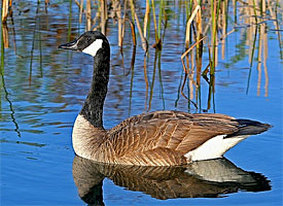Canada Goose (Branta canadensis)

Description: Large water birds with a
long black neck, black head, white “chin strap,” tan breast, mottled gray-brown
back, white underbelly, and wide, flat, black beak. Their legs and tail are
also black. They can be anywhere from 7-14 pounds and are the most commonly
recognized large water bird.
Habitat: The most widely dispersed goose in North America. They can live near water, in grassy fields, ponds, lakes, reservoirs, bays, estuaries, marshes, city and suburban parks, golf courses, or in grain fields. These birds are drawn to grassy fields particularly because they can digest grass and wide open fields allow them to keep an eye out for predators when they are feeding their young. They can be found in an expansive elevation range, but prefer “riverine” areas for breeding. During the winter and migration months, they are commonly found in agricultural areas, foraging on grain, winter wheat, and pasture grasses.
Diet: In summer and spring, mainly feed on grass, sedges, skunk cabbage leaves, and eelgrass. During the fall and winter they eat berries, especially blueberries, seeds and agricultural grains, especially kernels from dry corn cobs. Because of their location in cities, some subspecies have adapted to eating domestic grasses.
Behaviors:
Habitat: The most widely dispersed goose in North America. They can live near water, in grassy fields, ponds, lakes, reservoirs, bays, estuaries, marshes, city and suburban parks, golf courses, or in grain fields. These birds are drawn to grassy fields particularly because they can digest grass and wide open fields allow them to keep an eye out for predators when they are feeding their young. They can be found in an expansive elevation range, but prefer “riverine” areas for breeding. During the winter and migration months, they are commonly found in agricultural areas, foraging on grain, winter wheat, and pasture grasses.
Diet: In summer and spring, mainly feed on grass, sedges, skunk cabbage leaves, and eelgrass. During the fall and winter they eat berries, especially blueberries, seeds and agricultural grains, especially kernels from dry corn cobs. Because of their location in cities, some subspecies have adapted to eating domestic grasses.
Behaviors:
- Graze while on land or feed on submerged water vegetation with their long necks or up-ending their bodies.
- During the winter, they migrate in flocks, sometimes mixing with Cackling Geese. During stopovers in migration, however, territorialism can often lead to physical violence.
- Courtship begins with mutual neck-dipping. They then go out onto the water and face each other and dip their necks. The female selects her mate based on how well he demonstrates he can protect her and their future goslings. She informs the male she has selected him by following him to land or by always standing next to him.
- Most geese, once paired remain together for the rest of their lives. However, there are cases in which the geese have “divorced” or sought another partner.
- The nest is a large open cup, consisting of dry grasses, lichens, mosses, and down and body feathers. The female makes the nest and incubates the eggs while the male stands guard, protecting her and their eggs.
- In general, Canada geese get smaller as you move northward, and darker as you go westward.

